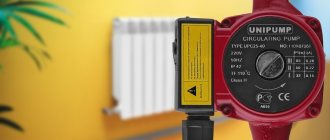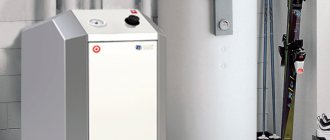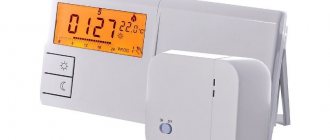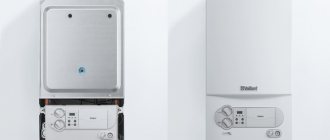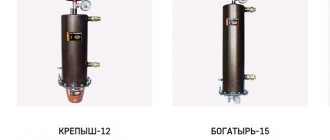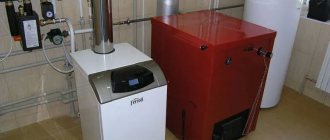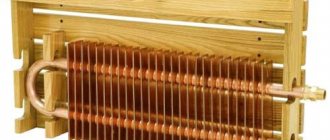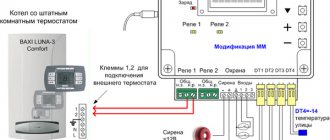Some simple models of electric boilers do not have smooth power adjustment, not to mention wider functionality. But even with degree-by-degree adjustment, the operation of the automation is based on measuring the temperature of the coolant in the supply and return of the boiler, which is not entirely effective: high accuracy cannot be achieved; high inertia is characteristic, i.e. a rather slow change in air temperature in the house.
But the main thing is that in the absence of precise adjustments, a lot of electricity is wasted.
The problem can be solved by installing a special room thermostat (thermostat) for an electric boiler, more expensive models of which measure the air temperature in the room and regulate the boiler operating mode in accordance with it, which is more correct and, most importantly, allows you to save from 10 to 50% of electricity. Moreover, the price of the issue is only 800-1000 rubles for simple mechanical models or 3-5 thousand rubles for more functional programmable thermostats controlled from a phone.
Types of thermostats
Thermostats fall into two main categories: mechanical, which are simpler in design and cheaper, and electronic, which are more intuitive and functional.
Mechanical thermostats are adjusted using a rotary temperature control wheel and an on/off button. The error of such a thermostat is usually 1-1.5 degrees. The thermostat operates using a special gas, the volume of which changes when the room temperature deviates from the set norm. When the temperature increases or decreases, the mechanical thermostat opens or closes the contacts, thereby turning on or off the burner in the boiler.
Electric thermostats are a little more complicated, but easy to use. Usually they have a display and several function buttons, with the help of which the temperature is regulated. At the same time, on many models you can also set different temperature conditions for day and night, thereby creating a comfortable temperature for sleep. This feature is also useful for work areas after work hours. This allows you to reduce gas costs.
The choice of one of the options depends entirely on your needs and boiler model. Some manufacturers of gas equipment recommend using mechanical thermostats for their equipment, since they do not support high-tech electronic ones. Therefore, before purchasing a thermostat and connecting it to the boiler, it is imperative that you familiarize yourself with the technical characteristics of your boiler and its compatibility with various devices.
Why do you need a stabilizer for an electric boiler?
A voltage stabilizer is an automatic device for electric heating boilers, which, like a thermostat, allows you to save money. But in this case, we are not talking about efficient energy consumption, but about the integrity and performance of the heating element as a whole.
A stabilizer for an electric heating boiler allows you to smooth out all differences in the operating characteristics of the electrical network during the day and obtain the correct sinusoidal voltage at the output, which will have a beneficial effect on the durability of the boiler. Stabilizers provide a high degree of protection of electrical appliances from ripple and voltage surges. High-quality equipment is highly sensitive, which is important for the electronic part of the boiler and thermostat. Stabilizers are characterized by an increased margin of network output power. This allows you to maintain the operating characteristics of the electrical network at the proper level even when the boiler is turned on.
Before purchasing a stabilizer, you must consult a specialist and clearly determine the type of equipment needed and its power.
Remote thermostats and choosing a location for their installation
A significant advantage in favor of electronic models can be the presence of remote thermostats. In this case, adjustment occurs using a separate panel, which can be placed in any place convenient for you. The choice of location for a remote thermostat in any building should be guided by safety and comfort parameters. It is better to place the thermostat out of the reach of children; it is also worth considering factors that can damage the device.
Currently, electronic thermostats with a Wi-FI module are also produced. Data from thermostats can be transferred directly to your smartphone using special applications created by developers. Using such applications, you can adjust the temperature remotely. Such models will fit perfectly into the “smart home” system.
Homemade external thermostat for the boiler: instructions
Below is a diagram of a homemade thermostat for a boiler, which is assembled using Atmega-8 and 566 series microcircuits, a liquid crystal display, a photocell and several temperature sensors. The Atmega-8 programmable microcircuit is responsible for compliance with the specified parameters of the thermostat settings.
Scheme of a homemade external thermostat for a boiler
Principle of operation
Let's move on to analyzing the principle of operation of a gas boiler directly, without a connected thermostat. Let's say your boiler is currently set to 60 degrees Celsius. As soon as the burner lights up, the temperature begins to tend to the preset value (in our case, 60 degrees). After reaching this temperature, the burner turns off, and the pump that cools the coolant in the heating system continues to work, and the water temperature drops.
It is also worth understanding what is happening in the boiler electronics at this time. While the boiler is heating up, a certain signal passes unhindered from point A to point B along a closed circuit. As soon as the temperature reaches the required values, the circuit opens and the burner goes out. The network is disconnected by nothing more than a piece of wire, the so-called jumper. A relay thermostat, in its essence, is also such a jumper, only it works not based on the water temperature, but taking into account the air temperature in the room.
Connecting a thermostat to an electric boiler, Connecting a thermostat to an electric boiler
Dropping by
Group: New users Messages: 3 Registration: 1/28/2019 User No.: 55226
It has an electric boiler, it has its own thermostat for the temperature of the liquid, it works, everything is fine. I want to connect an external thermostat to the room temperature. Based on the boiler diagram, I figured out that with the connection of the built-in thermostat, there are two inputs of an external device, closed by a jumper. Essentially a serial wire that passes a phase, a break turns off the boiler. I took out the jumper and replaced it with two wires, then I try to connect them to the thermostat. Below I give a thermostat diagram with instructions.
Connection diagram
Almost all thermostats existing on the modern market are relay. This means that they operate via a relay that opens and closes contacts based on a temperature preset by the user. As a theoretically connected thermostat, we will use an electric relay-type thermostat with dry contacts. Dry contacts are a term that means that in any state, closed or open, there is no voltage across the contacts.
To connect to the boiler, there are terminals on the thermostat; you need to connect the open and common ports. If they are not indicated in the manual for your specific model, you just need to ring the contacts with a tester. Next, we need to make sure that the thermostat can be connected to the boiler. Usually this is indicated directly in the technical documentation; if there is none, then the information can be easily found in any of the search engines.
The found electronic circuit diagram of the board indicates the location of the very jumper into which the thermostat will be connected to the boiler. Depending on the boiler model, you will have to unscrew several bolts to get to the required part. The block can be installed either on the control board or taken out separately. Connecting the thermostat for any of these options will be no different.
Next, you need to pull out the jumper, and in its place put the cable supplied with the thermostat (or purchased separately). This is a two-core wire with a cross-section of at least 0.75 square millimeters. The polarity when connecting does not matter. The cable is connected to the thermostat control unit into the normal open and common ports, as described above. The ports are located on one side of the control unit, and on the other there are ports for connecting the power supply cable. You can either purchase a new cable of the desired cross-section or use the complete one.
This completes the connection of the thermostat to the gas boiler. All that remains is to check the functionality of the system. On the thermostat we set the required air temperature in the room, the signal is transmitted to the control unit and, depending on the set temperature, the relay contacts close or open. When setting a temperature that is lower than the current one, the burner starts heating the water in the system; when setting a temperature higher, the burner, on the contrary, starts working.
Functions of room thermostats for gas boilers
Before you buy a room thermostat for a gas boiler of one type or another, you should familiarize yourself with its functionality. It should be noted that when choosing between analog and digital models, the latter have a lot of advantages and, accordingly, their price is higher.
Installing a room thermostat for a gas boiler will help reduce fuel costs for heating the room.
However, the use of a programmable room thermostat for a heating boiler can significantly reduce the frequency of equipment switching on/off, which has a positive effect on its overall operation.
An extremely important feature of a room thermostat for a boiler is the programming function, which makes it possible to set a comfortable microclimate depending on the time of day, weather conditions and other factors. The available timer allows you to set the necessary parameters, taking into account the days of the week (working, weekends), calendar season and other settings. This is very convenient for those who have a shift work schedule or work part-time.
The main advantages of a programmable room thermostat for a gas boiler:
- remote control of the heating device;
- the “day/night” setting makes it possible to set an individual heating level taking into account a certain time of day;
- ease of control allows you to quickly reconfigure the temperature in the room;
The operating principle of a room thermostat for a gas boiler.
- the programming option makes it possible to configure the operation of the equipment taking into account weather changes;
- Due to minimal switching on/off, wear is minimized and the service life of heating equipment is extended;
- significant savings in energy consumption;
- high accuracy and reliability in operation.
On a note! By purchasing a room thermostat for a programmable boiler, you get the opportunity to control heating equipment at any time of the day, regardless of your presence in the house.
Advantages
Thus, we have completely disassembled the principle of operation of a heating system using an electronic or mechanical thermostat. This is a very convenient solution for several reasons:
- Eliminates the need to manually adjust the water temperature to keep the room at a comfortable temperature.
- When using a wireless thermostat, there is also no need to adjust the boiler itself; this is extremely convenient if the boiler is placed in a separate room - the boiler room.
- It becomes possible to set different temperatures for day and night, this significantly saves gas at night.
What are thermostats for an electric boiler?
Why are they needed and how are they used?
Simple mechanical thermostat.
The temperature regulator is a wired or wireless control panel that is mounted on the wall in any convenient place.
There are both simple mechanical models, the functionality of which is smooth degree-by-degree temperature control (especially important for electric boilers with mediocre 3- or 6-step power control), and automatic programmable models with an information display, which allow you to configure more than 50 parameters of the boiler operation and program them change for the next day or even week.
Automatic thermostats allow you to adjust the operation of the boiler once and up to a whole or even several heating seasons.
In general, room thermostats for electric boilers perform the following functions:
- measurement, control and maintenance of a certain comfortable temperature of the working environment;
- transmitting signals to the electric boiler from any place in the house convenient for the owner;
- protection against overheating or freezing of the heating system;
- programming the operating mode for the next day or week;
- remote control from a phone if the thermostat has Wi-Fi or a GSM module;
- remote notification (including via smartphone) about malfunctions and emergency situations in the operation of the heating system.
Existing types
The settings specified on the thermostat take precedence over the settings of the electric boiler itself. The operating principle of the device depends on the type of temperature sensor used in it:
1. Mechanical thermostats
The simplest models, the operating principle of which is based on the operation of membrane and capillary temperature sensors. They use substances placed in a capsule that expand significantly at the slightest increase in temperature. When the expanding substance reaches the maximum temperature threshold, it puts pressure on the relay membrane, as a result of which the contacts open, and the thermostat sends a signal about a partial or complete reduction in the power of the electric boiler.
The main disadvantages of such thermostats are simple functionality, limited to turning a round rotator to set the desired temperature, and a high error - up to 3-4°C.
2. Electromechanical
They have a more complex design based on the use of special metal plates as a heat-sensitive element, which produce a micro-discharge when heated to a certain temperature. The micro-discharge activates an electromagnetic relay that controls a mechanical valve. In general, electromechanical thermostats have +- the same functionality, but a much smaller error; their cost is 20-40% higher.
3. Electronic
The most modern and multifunctional devices, equipped with electrical boards (automation), often with remote sensors: both internal and external (street). Capable of maintaining or changing the operating mode of an electric boiler without human intervention. Allow a minimum error of up to 0.5-0.7 degrees. We recommend paying attention to electronic thermostats due to their functionality and cost-effectiveness.
The automation of modern models is capable of maintaining the most economical mode of operation of the electric boiler, constantly adjusting its operation in accordance with the temperature in the working room, which completely prevents unnecessary energy consumption. After all, reducing the temperature by 1°C is up to 5% savings.
How to choose an external temperature sensor and organize weather-dependent boiler control
Review of the best models
TEPLOCOM TS-Prog-2AA/8A
A wired programmer with an affordable price. It can control not only the operation of a gas boiler, but also the “warm floors” system. The large display allows you to display many current parameters. This model performs the following functions:
- protects the pump;
- prevents freezing of the coolant;
- sets the hourly operating mode for the week;
- displays the current state of the gas boiler.
The programmer is powered by two batteries, and the temperature adjustment range is from +5 to +35°C. The approximate cost of the device is 3300 rubles.
Baxi Magictime Plus
This programmer is designed to work with gas boilers of the same brand. The model has a compact body and a large display. It has a high adjustment accuracy of 0.1°C. The work program can be set a week in advance. Connects to the gas unit using a wire line.
The programmer operates using two AA batteries. Can be controlled using a telephone. The approximate cost is 7,000 rubles.
Momit Home Thermostat
Refers to modern models with advanced functionality. This wireless programmer is equipped with a motion sensor. If it detects that there is no one at home, the device sends a signal to the gas boiler to turn off, thus reducing the temperature in the room.
The device also connects to a Wi-Fi network and can be controlled from a smartphone.
The programmer has a new function that allows you to adjust to the lighting. It can be installed even in a place where the sun's rays fall. The light sensor built into the device can compensate for temperature imbalances.
The programmer also has many other advantages:
- compatibility with boilers from different manufacturers;
- large LED display;
- presence of a humidity sensor;
- Possibility to install on a table.
A programmer with such qualities is not cheap - about 11,000 rubles.
Auraton 1300
This weekly programmer is compatible with heating devices of various models. Data transmission is carried out through wires. Its LCD screen displays information about the room temperature.
The control range of the gas boiler is from 0 to 35°C. Power is supplied by two alkaline batteries. This model has a low price - 2500 rubles.
Weekly programmers Salus UK
The temperature regulator for electric boilers from Salus, model T105RF, is a wireless weekly programmer that allows you to set two temperature levels: “comfortable” and “economical” in the range of 7-30 0 C, in increments of 0.5 0 C.
For any day of the week, you can set one of 9 programs, 6 of which have hard factory settings, 3 of which can be set by users themselves. The device is equipped with a large informative display with blue backlight.
The programmer of this model can be used with any gas and electric heating units that have terminals for connecting a thermostat.
Attention! If several sets are connected at one facility, you can select one of 32 communication codes, which eliminates mutual negative influence of the equipment. If when choosing a thermostat its cost plays an important role, then you can choose a cheaper wired model
If cost plays an important role when choosing a thermostat, then you can choose a cheaper wired model.
